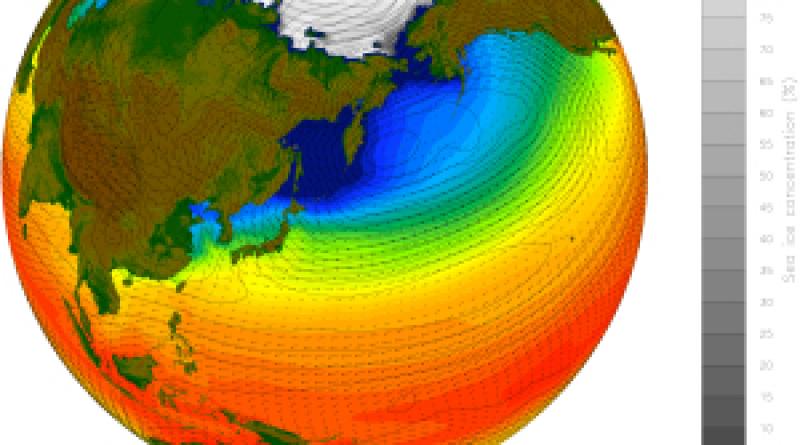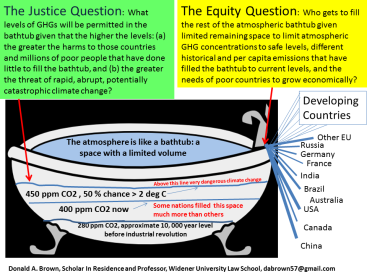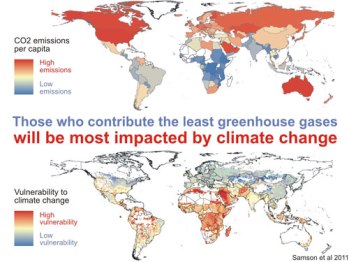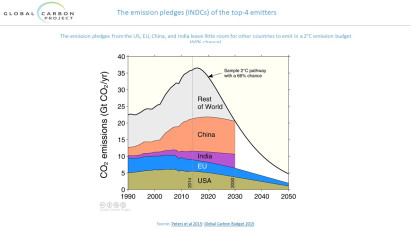6 Αλήθειες για την Κλιματική Αλλαγή που πρέπει όλοι να μάθουν.

Six Things That Citizens Around the World Urgently Need to Know About Climate Change In Light of Several Recent Scientific Reports
This article identifies and explains six things that most citizens around the world, although particularly those in developed countries, need to understand about climate change in light of the most recent climate change science. These six things are:
- The enormous magnitude of GHG emissions reductions needed to prevent catastrophic warming.
- The speed of GHG emissions reductions needed to prevent catastrophic warming.
- No nation may either legally or morally use national self-interest alone as justification for their failure to fully meet their obligation under the UNFCCC.
- No nation may either legally or morally use scientific uncertainty as justification for their failure to fully meet their obligations under the UNFCCC.
- Developed countries must legally, morally, and practically more aggressively reduce their GHG emissions than developing countries
- Developed countries must legally, morally, and practically help finance mitigation and adaptation programs in poor developing countries.
The need for broad understanding among civil society of these issues follows from several recent scientific reports on climate change. For instance, on October 8, 2018, the Intergovernmental Panel on Climate Change (IPCC) issued a Special Report on limiting global warming to 1.5 degrees C above pre-industrial temperatures. This landmark report, along with several additional recent scientific studies published in the last few months including a paper published by the Proceedings of the US National Academy of Sciences on July 21, 2018, Trajectories of the Earth System in the Anthropocene by Steffen et.al., and a paper published in mid-August of this year in Nature Communications by Anthony et. al., 21st-Century Modeled Permafrost Carbon Emissions Accelerated by Abrupt Thaw Beneath, lead to the conclusion that the international community is facing an urgent existential crisis that threatens life on Earth. Preventing this catastrophe requires the entire international community at all levels of government (national, state, regional, and local) to engage immediately in an unprecedented effort to rapidly reduce GHG emissions to net zero in the next few decades.
Although the October IPCC report on 1.5 degrees C warming received some significant notice in the US media, the recent US elections on November 6th in which climate change played only a very minor role at best, demonstrates a startling lack of understanding about the enormity and urgency of the climate threat facing the international community. Because of the immense ramp-up of programs and efforts needed to reduce the staggering threat of climate change depends on broad understanding of the scale of the problem facing the human race, and given the apparent ignorance of most citizens about the magnitude and urgency of the climate change crisis and other issues discussed in this paper, concerned citizens need to mount an aggressive educational program to inform civil society about aspects of the climate change threat that appear to be poorly understood. These issues include the following:
1. The Immense Magnitude of GHG Reductions Urgently Needed to Prevent Catastrophic Warming
The IPCC Special Report concludes that limiting global warming to 1.5°C would require rapid, far-reaching, and unprecedented changes in all aspects of society. This is so because to limit warming to 1.5 C, CO2 emissions would need to fall by about 45 percent from 2010 levels by 2030, reaching ‘net zero’ around 2050 according to the IPCC Special Report. This means if global CO2 emissions have not fallen to net zero levels by 2050, any remaining emissions would need to balanced by removing CO2 from the air.
The Steffen et. al. paper also describes how the positive feedbacks depicted in the following graphic, once triggered could initiate other feedbacks creating a cascade of positive feedbacks, each of which could speed up the warming which is already causing great harm and suffering around the world. The paper claims this mechanism could make life on much of the Earth uninhabitable which could lead to social collapse on the global scale and ultimately to warming increases that human reductions of greenhouse gases (GHG) emissions alone would not prevent additional warming until the global system reached a new temperature equilibrium at much higher temperatures than the human race has ever experienced. In other words, cascading positive feedbacks in the climate system could result in humans losing control over reducing disastrous warming.
The Steffen et.al paper also explains how human-induced warming of slightly over 1.0 degrees C is already rapidly approaching levels that may trigger positive climate feedbacks which could greatly accelerate the warming already plaguing the world by causing record floods, deadly heat waves, droughts, increasing tropical diseases, forest fires, more intense and damaging storms, sea level rise, coral bleaching, acidification of oceans, all of which are contributing to increasing the number of refugees which are destabilizing governments around the world.
The Anthony et.al paper also explains that, contrary to common assumptions previously made by many in the international community that positive feedbacks in the climate system that could cause abrupt temperature increases would not likely be triggered if warming could be limited to below 20 C above pre-industrial levels, positive feedbacks could be initiated between current temperatures which have risen slightly above 1.10 C and 20 C. Moreover, the additional warming caused by these feedbacks could initiate other feedbacks creating a cascade of positive feedbacks, each of which could speed up the warming which is already causing great harm and suffering around the world, phenomena which threaten life on earth.
For these reasons, citizens around the world need to understand the urgent need to reduce GHG emissions to net zero as soon as possible.
2. The Speed of GHG Reductions Needed to Prevent Catastrophic Warming.
Every day that nations fail to reduce their GHG emissions to levels required of them to achieve a warming limit goal such as 2 degrees C makes the problem worse because the carbon budgets for the whole world that must constrain global emissions to achieve any warming limit goal shrink as emissions continue. Therefore, the speed that nations reduce their GHG emissions reductions is as important as the magnitude of the reductions identified by any national GHG reduction commitment. For this reason, any national commitment on climate change should not only identify the amount of GHG emissions that will be reduced by a certain date, but also the reduction pathway by which these reductions will be achieved.
The following illustration depicts two different GHG reduction pathways for reaching zero emissions by 2050. Although the curve on the top achieves zero GHG emissions at the same time as the curve on the bottom, total emissions during the period are much greater following the emissions reductions pathway under the top curve compared to total emissions under the bottom curve because the lower curve pathway more quickly reduces emissions. Citizens need to understand that waiting to reduce GHG emissions makes the problem worse because waiting consumes more of any shrinking carbon budget that must constrain global emissions to achieve any warming limit goal.
![]()
3. No Nation may either Legally or Morally use National Self-interest Alone as Justification for Their Failure to Fully Meet Their Obligations under the UNFCCC.

Because GHG emissions from every country mix rapidly in the atmosphere, all nations’ emissions are contributing to rising atmospheric GHG concentrations thus harming people and ecological systems on which life depends all over the world. The above illustration depicts that the atmosphere is analogous to a bathtub in that it has limited volume and that all nations emitting GHGs are raising atmospheric concentration of GHGs to its current concentration of approximately 407 ppm CO2 (the second line from the bottom in the above bathtub) which level is already causing enormous harm in many vulnerable countries while threatening the entire world if the atmospheric GHG concentration is raised to levels which trip positive feedbacks discussed above (represented by the upper line in the above bathtub). Thus high-emitting countries such as the US may not formulate their climate change policies on the basis of costs and benefits to itself alone. Particularly those nations that are emitting high levels of GHGs must acknowledge and respond to the devastating climate change harms they are already contributing to in other countries and particularly harms to poor people and nations that are most vulnerable to climate change impacts. Thus in the United States, for instance, the Trump administration’s justification for withdrawing the United States from the Paris Agreement on the basis of “putting US interests first ” is ethically indefensible and tragic because of the damage the Trump climate change policy will cause outside the United States.
The following illustration depicts nations emitting high levels of GHG in red in the top half of the illustration while those countries most vulnerable to climate change impacts are indicated in red in the bottom half of the illustration.

For this reason, as a matter of law, given that nations under the UNFCCC agreed to stabilize GHG concentrations in the atmosphere at a level that would prevent dangerous anthropogenic interference with the climate system. (UNFCCC, Art. 2), a nation may not fail to reduce its GHG emissions to its fair share of safe global emissions based on the cost to it because it has ethical and legal duties to other nations not to harm them.
4. Scientific Uncertainty is Not a Legally or Morally Defensible Justification for Not Adopting Aggressive Climate Change Policy Responses.
Although opponents of climate change policies have justified their opposition on the basis of scientific uncertainty, and despite the fact that the most prestigious scientific organizations have expressly stated their conclusions about the enormous threat of climate change with increasingly higher levels of scientific probability for over 40 years, scientific uncertainty is not a justifiable response for any nation’s unwillingness to adopt climate change policies as a matter of law or morally.
Under international law, including the 1992 United Nations Framework Convention on Climate Change (UNFCCC, Art. 3.3) which states in relevant part “where there are threats of serious or irreversible damage, lack of full scientific certainty may not be used as a reason for postponing such measures,” and the “no harm principle”, a principle of customary international law recognized in the Preamble to the UNFCCC, nations may not legally use scientific uncertainty as an excuse for failing to take action to prevent dangerous climate change.
Also as we explained previously in 2008 in The Ethical Duty to Reduce Greenhouse Gas Emissions in the Face of Scientific Uncertainty, nations also have had a strong moral responsibility to take action to reduce the threat of climate change once it was scientifically understood that GHG emissions could cause serious harms even if the harms had not been proven with high degrees of scientific certainty.
Given, that numerous reputable scientific organizations beginning in the late 1970s, including the US National Academies of Sciences, (See Early Climate Change Consensus at the National Academy) and five reports from the Intergovernmental Panel on Climate Change beginning in 1990 (See IPCC report timeline) have concluded with increasing levels of certainty that human activities are dangerously threatening people and ecological systems on which life depends, nations have been on strong notice for over four decades that human activities responsible for GHG emissions are dangerous to the human community, thus nations have been on notice about the dangers of climate change for over 40 years and therefore may not legally or morally use scientific uncertainty as an excuse for failing to adopt climate change policies that will reduce their GHG emissions to levels required of them to prevent dangerous climate change.
5. High Emitting Developed Countries, Including the United States, Must Reduce GHG Emissions More Aggressively than Other Countries as a Matter of Law and Practically to Prevent Dangerous Climate Change.
Hiigh-emitting nations have a legal duty under the UNFCCC to reduce their GHG emissions faster than lower emitting nations because they agreed to:
[P]rotect the climate system for the benefit of present and future generations of humankind, on the basis of equity and in accordance with their common but differentiated responsibilities and respective capabilities. Accordingly, the developed country Parties should take the lead in combating climate change and the adverse effects thereof. (UNFCCC, 1992, Art 3.1)
These principles were re-committed to in the Paris Agreement , Art 2.2 which provides that:
This Agreement will be implemented to reflect equity and the principle of common but differentiated responsibilities and respective capabilities, in the light of different national circumstances.
Thus under law, hiigh emitting nations, such as the US, have a legal duty under the concept of “equity” to reduce its GHG emissions more rapidly than most other nations. Although there is reasonable disagreement among nations about what “equity” requires of them, formulate its ghg emissions reduction target on the basis of equity is not only required by its legal obligations under the UNFCCC, practically the US and other high emitting nations must reduce their GHG emissions by much greater amounts and faster than poor developing nations because if they don’t the poorer nations will have to reduce their GHG emissions almost immediately to near zero CO2 so that global emissions don’t exceed the carbon budget available to prevent a warming limit such as 2 degrees C from being exceeded,
- There is a basic set of shared ethical principles and precedents that apply to the climate problem…[and] such principles… can put bounds on the plausible interpretation of equity in the burden sharing context…[and] are important in establishing what may be reasonably required of different actors. (IPCC, 2014, AR5, WG III, Ch. 4, pg .317 )
The IPCC went on to say:
- these equity principles can be understood to comprise four key dimensions: responsibility, capacity, equality and the right to sustainable development (IPCC, , AR5, WG III, Ch 4, p. 318).
As a matter of law, therefore, high-emitting countries such as the United States must reduce its GHG emissions to safe levels based on equity at faster levels than other countries as any reasonable interpretation of equity would require the US to make much larger and more rapid GHG reductions than almost all other nations given that the United States (under the concept of responsibility) emitted 5,011,687 metric kilotons (kt) of CO2 equivalent emissions in 2016, second only to China’s 10,432,741 kt CO2. (Netherlands Environmental Agency), also under the concept of responsibility the United States has emitted a greater amount of cumulative CO2 emissions, that is 29.3% of global CO2 emissions between 1850 and 2002, while China emitted 7.6% during the same period, (WRI, Cumulative Emissions) making the US much more responsible for raising atmospheric concentrations of CO2 to the current level of approximately 406 ppm than any country. Also, under the concept of equality given the US is responsible for 15.56 metric tons per capita CO2 emissions which is more than twice as much as China’s 7.45 metric tons per capita in 2016 (World Bank), as a matter of equity the US must reduce its GHG emissions much more rapidly and steeply than almost all countries.
The following illustration demonstrates why high-emitting nations must also practically reduce emissions more aggressively than other nations because it can be seen that if the high emitting nations such as China, the EU, and USA, depicted near the bottom of the illustration, don’t reduce GHG emissions muchfaster than the rest of the world, and if the international community is going to be restrained by the emissions reduction pathway needed to achieve a warming limit goal, such as the 2 degee C pathway depicted in the illustration, then there is quickly nothing left for the rest of the world. Therefore, high-emitting nations must more aggressively reduce their emissions than lower emitting nations not only as a matter of law but also to retain any hope for the international community to achieve warming limit goals agreed to in the Paris Agreement of as close as possible to 1.5 degrees C but no greater than 2 degrees C.

6. Developed Nations Have a Legal and Moral Duty to Provide Financial Resources to Assist Developing Nartions with both Mitigation and Adaptation Programs and this Financial Assistance is also Practically Indespensible to Prevent Climate-induced Harms in all Countries.
Under the UNFCCC, developed country Parties agreed to provide financial resources to assist developing country Parties in implementing the objectives of the Convention (UNFCCC, Article 4, §3). The Paris Agreement also provides that the developed countries shall provide financial resources to assist developing country Parties with respect to both mitigation and adaptation in continuation of their existing obligations under the Convention.(Paris Agreement, Art, 9.1)
Financial support of developing nation’s mitigation obligations under the UNFCCC mitigations is not only legally required under the UNFCCC but also practically important because large-scale investments are required to significantly reduce emissions and dangerous climate change will not likely be avoided unless developing nations reduce their GHG emissions to their fair share of safe global emissions. Financial support for developing nations by developed nations is also both legally and ethically required to meet the adaptation needs of developing countries, as significant financial resources are needed by many vulnerable countries to adapt to the adverse climate change.
Climate impacts, such as sea-level rise and more frequent droughts and floods, are already having devastating effects on communities and individuals in developing countries. These impacts on developing countries are already affecting developed nations because, for instance, between 2008 and 2011, approximately 87 million people were displaced due to extreme weather events which is causing a mass migration of refugees which is destabilizing many developed nations, particularly in Europe.(Climate Change in Developing Countries, Government of Canada) According to the World Health Organization, climate change is expected to contribute to approximately 250,000 additional deaths per year from malnutrition, malaria, diarrhea and heat stress.(World Health Organization, Climate and Health) .
Developing countries are the most impacted by climate change. This is due to many factors, including the economic importance of climate-sensitive sectors for these countries (e.g. agriculture) and the limited financial and human capacity to respond to the impacts of climate change. (Climate Change in Developing Countries, Government of Canada). The Food and Agriculture Organization of the United Nations estimates that by 2030, up to 122 million more people could be forced into extreme poverty due to the effects of climate change—many of them women. (Conflicts Fueled by Climate Change, The Guardian.)
Because climate change is already destabilizing developed countries due to refugees who are fleeing vulnerable areas of poor developing nations that have become inhabitable due to climate change-induced droughts, floods, loss of drinking water, and rising seas, if developed nations do not help finance climate change adaptation programs in developing countries, they will experience growing conflict and stress caused by vulnerable people and refugees in developing countries who are both creating conflicts in their countries and in developed countries they have or are seeking to enter. .
The following illustration depicts the number of refugees who are fleeing or who have fled climate change.
![]()
Conflicts Fueled by Climate Change, The Guardian.
For this reason, developed country financing assistance for emissions reduction and adaptation programs in developing countries is not only legally required but practically necessary to reduce climate change-induced problems and conflicts in developed countries.
By Donald A. Brown, Scholar in Residence and Professor Widener University Commonwealth Law School
28 November 2018
ethicsandclimate.org




